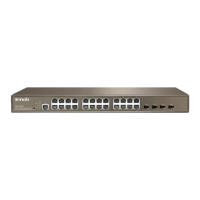User Guide
33
Benefits of Link Aggregation
1) Double bandwidth:
Aggregation-enabled devices treat all physical links (ports) in an aggregation group entirely as a single
logical link (port). Data transmitted to a specific host (destination address) will always be transmitted over
the same port in a trunk group. This allows packets in a data stream to arrive in the same order they were
sent. Link aggregation groups multiple Ethernet ports together in parallel to act as a single logical link.
This gives a bandwidth that is a multiple of a single link's bandwidth.
2) Backup and redundancy:
Load balancing is automatically applied to the ports in the aggregated group, and a link failure within the
group causes the network traffic to be directed to the remaining links in the group. The Spanning Tree
Protocol will treat a link aggregation group as a single link, on the switch level. On the port level, the STP
will use the port parameters of the Master Port in the calculation of port cost and in determining the state
of the link aggregation group. If two redundant link aggregation groups are configured on the Switch, STP
will block one entire group. In the same way, STP will block a single port that has a redundant link.
Link Aggregation Mode
1) Static Aggregation
For static aggregation, you must manually maintain the aggregation state of the member ports as system
does not allow adding a new port or deleting any existing member port. Down to 2 member ports must be
included in a single aggregation group. LACP is disabled on the member ports in static LACP mode.
Ports in static aggragation group must all be of the same port speed and will stay in forwarding state. In
case a certain port is set to a different speed, packets on it will be forwarded at the actual connection
speed. The rate of the aggregation group equals the total rate of its member ports.
2) LACP

